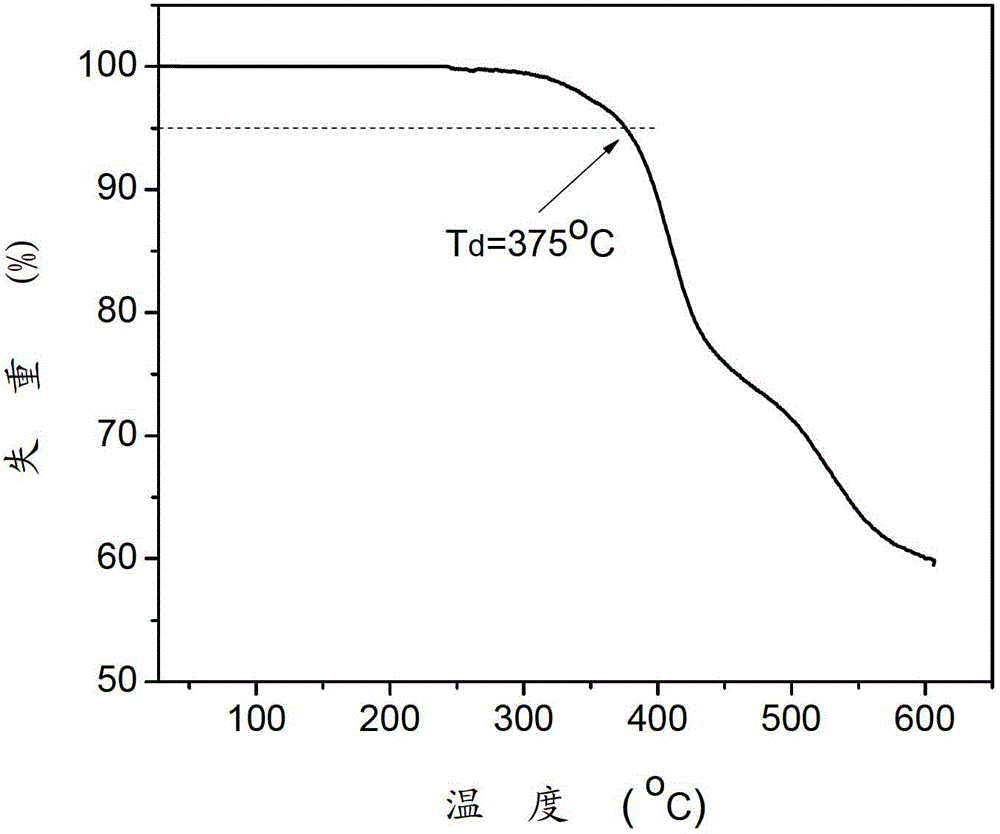Polymer containing tetraphenyl silicane and carbazole unit as well as preparation method and application of the polymer
A technology of carbazole unit and tetraphenyl silicon, applied in the field of organic electroluminescent device materials, can solve the problems of complex synthesis and harsh preparation conditions, achieve good hole transport performance, improve efficiency, improve solubility and film formation performance effect
- Summary
- Abstract
- Description
- Claims
- Application Information
AI Technical Summary
Problems solved by technology
Method used
Image
Examples
Embodiment 1
[0028] The polymer containing tetraphenyl silicon and carbazole units in this example, namely poly{bis(4-yl-phenyl)diphenylsilane-co-3,6-diyl-9-n-hexylcarbazole }(P1) (where R is n-hexane, n=63), its structural formula is as follows:
[0029]
[0030] The preparation steps of above-mentioned polymer are as follows:
[0031] The reaction formula is as follows:
[0032]
[0033] Under argon protection, bis(4-bromophenyl)diphenylsilane (99mg, 0.2mmol), 9-n-hexylcarbazole-3,6-dipinacol borate (101mg, 0.2mmol ) into a flask filled with 10ml of toluene solvent, and after fully dissolving, potassium carbonate (2mL, 2mol / L) solution was added into the flask, vacuumed to deoxygenate and filled with argon, and then added bistriphenylphosphine dichloride Palladium (5.6mg, 0.008mmol); the flask was heated to 100°C for Suzuki coupling reaction for 48h. Subsequently, the polymerization reaction was stopped after cooling down, and 50 ml of methanol was added dropwise to the flask for...
Embodiment 2
[0037] The polymer containing tetraphenyl silicon and carbazole units in this example is poly{bis(4-yl-phenyl)diphenylsilane-co-3,6-diyl-9-methylcarbazole} (P2) (where R is methyl, n=100), its structural formula is as follows:
[0038]
[0039] The preparation steps of above-mentioned polymer are as follows:
[0040] The reaction formula is as follows:
[0041]
[0042] Under the protection of mixed gas of nitrogen and argon, bis(4-bromophenyl)diphenylsilane (148mg, 0.3mmol), 9-methylcarbazole-3,6-dipinacol borate (130mg, 0.3mmol) and 15mL tetrahydrofuran were added into a 50mL two-neck bottle, fully dissolved, and then a mixture of nitrogen and argon was introduced to exhaust the air for about 20 minutes, and then tetrakistriphenylphosphine palladium (4mg, 0.003mmol) was added into it, fully After dissolving, add sodium bicarbonate (3mL, 2mol / L) solution. Then, the mixed gas of nitrogen and argon was exhausted for about 10 minutes, and the two-neck flask was added to...
Embodiment 3
[0045] The polymer containing tetraphenyl silicon and carbazole units in this example is poly{bis(4-yl-phenyl)diphenylsilane-co-3,6-diyl-9-n-eicosyl Carbazole} (P3) (where R is n-eicosyl, n=91), its structural formula is as follows:
[0046]
[0047] The preparation steps of above-mentioned polymer are as follows:
[0048] The reaction formula is as follows:
[0049]
[0050] Under nitrogen protection, bis(4-bromophenyl)diphenylsilane (148mg, 0.3mmol), 9-n-eicosylcarbazole-3,6-dipinacol borate (231mg, 0.33mmol ), palladium acetate (3.5mg, 0.015mmol) and tris(o-methoxyphenyl)phosphine (21mg, 0.06mmol) were added to a flask containing 12mL of N,N-dimethylformamide, and after fully dissolving Potassium carbonate (3mL, 2mol / L) solution was added, and then the flask was purged with nitrogen for about 30min; the flask was heated to 130°C for Suzuki coupling reaction for 12h. Subsequently, stop the polymerization reaction after cooling down, add 40mL methanol to the flask fo...
PUM
| Property | Measurement | Unit |
|---|---|---|
| thickness | aaaaa | aaaaa |
| thickness | aaaaa | aaaaa |
| thickness | aaaaa | aaaaa |
Abstract
Description
Claims
Application Information
 Login to View More
Login to View More - R&D
- Intellectual Property
- Life Sciences
- Materials
- Tech Scout
- Unparalleled Data Quality
- Higher Quality Content
- 60% Fewer Hallucinations
Browse by: Latest US Patents, China's latest patents, Technical Efficacy Thesaurus, Application Domain, Technology Topic, Popular Technical Reports.
© 2025 PatSnap. All rights reserved.Legal|Privacy policy|Modern Slavery Act Transparency Statement|Sitemap|About US| Contact US: help@patsnap.com



